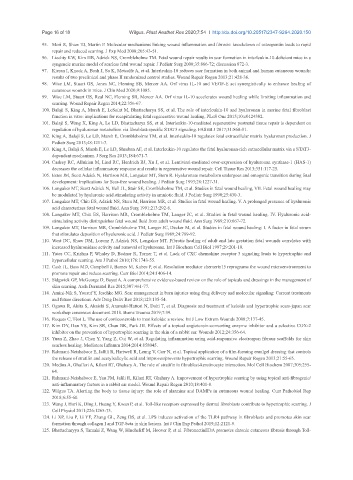Page 637 - Read Online
P. 637
Page 16 of 18 Wilgus. Plast Aesthet Res 2020;7:54 I http://dx.doi.org/10.20517/2347-9264.2020.150
95. Mori R, Shaw TJ, Martin P. Molecular mechanisms linking wound inflammation and fibrosis: knockdown of osteopontin leads to rapid
repair and reduced scarring. J Exp Med 2008;205:43-51.
96. Liechty KW, Kim HB, Adzick NS, Crombleholme TM. Fetal wound repair results in scar formation in interleukin-10-deficient mice in a
syngeneic murine model of scarless fetal wound repair. J Pediatr Surg 2000;35:866-72; discussion 872-3.
97. Kieran I, Knock A, Bush J, So K, Metcalfe A, et al. Interleukin-10 reduces scar formation in both animal and human cutaneous wounds:
results of two preclinical and phase II randomized control studies. Wound Repair Regen 2013;21:428-36.
98. Wise LM, Stuart GS, Jones NC, Fleming SB, Mercer AA. Orf virus IL-10 and VEGF-E act synergistically to enhance healing of
cutaneous wounds in mice. J Clin Med 2020;9:1085.
99. Wise LM, Stuart GS, Real NC, Fleming SB, Mercer AA. Orf virus IL-10 accelerates wound healing while limiting inflammation and
scarring. Wound Repair Regen 2014;22:356-67.
100. Balaji S, King A, Marsh E, LeSaint M, Bhattacharya SS, et al. The role of interleukin-10 and hyaluronan in murine fetal fibroblast
function in vitro: implications for recapitulating fetal regenerative wound healing. PLoS One 2015;10:e0124302.
101. Balaji S, Wang X, King A, Le LD, Bhattacharya SS, et al. Interleukin-10-mediated regenerative postnatal tissue repair is dependent on
regulation of hyaluronan metabolism via fibroblast-specific STAT3 signaling. FASEB J 2017;31:868-81.
102. King A, Balaji S, Le LD, Marsh E, Crombleholme TM, et al. Interleukin-10 regulates fetal extracellular matrix hyaluronan production. J
Pediatr Surg 2013;48:1211-7.
103. King A, Balaji S, Marsh E, Le LD, Shaaban AF, et al. Interleukin-10 regulates the fetal hyaluronan-rich extracellular matrix via a STAT3-
dependent mechanism. J Surg Res 2013;184:671-7.
104. Caskey RC, Allukian M, Lind RC, Herdrich BJ, Xu J, et al. Lentiviral-mediated over-expression of hyaluronan synthase-1 (HAS-1)
decreases the cellular inflammatory response and results in regenerative wound repair. Cell Tissue Res 2013;351:117-25.
105. Estes JM, Scott Adzick N, Harrison MR, Longaker MT, Stern R. Hyaluronate metabolism undergoes and ontogenic transition during fetal
development: Implications for Scar-free wound healing. J Pediatr Surg 1993;28:1227-31.
106. Longaker MT, Scott Adzick N, Hall JL, Stair SE, Crombleholme TM, et al. Studies in fetal wound healing, VII. Fetal wound healing may
be modulated by hyaluronic acid stimulating activity in amniotic fluid. J Pediatr Surg 1990;25:430-3.
107. Longaker MT, Chiu ES, Adzick NS, Stern M, Harrison MR, et al. Studies in fetal wound healing. V. A prolonged presence of hyaluronic
acid characterizes fetal wound fluid. Ann Surg 1991;213:292-6.
108. Longaker MT, Chiu ES, Harrison MR, Crombleholme TM, Langer JC, et al. Studies in fetal wound healing. IV. Hyaluronic acid-
stimulating activity distinguishes fetal wound fluid from adult wound fluid. Ann Surg 1989;210:667-72.
109. Longaker MT, Harrison MR, Crombleholme TM, Langer JC, Decker M, et al. Studies in fetal wound healing: I. A factor in fetal serum
that stimulates deposition of hyaluronic acid. J Pediatr Surg 1989;24:789-92.
110. West DC, Shaw DM, Lorenz P, Adzick NS, Longaker MT. Fibrotic healing of adult and late gestation fetal wounds correlates with
increased hyaluronidase activity and removal of hyaluronan. Int J Biochem Cell Biol 1997;29:201-10.
111. Yates CC, Krishna P, Whaley D, Bodnar R, Turner T, et al. Lack of CXC chemokine receptor 3 signaling leads to hypertrophic and
hypercellular scarring. Am J Pathol 2010;176:1743-55.
112. Cash JL, Bass MD, Campbell J, Barnes M, Kubes P, et al. Resolution mediator chemerin15 reprograms the wound microenvironment to
promote repair and reduce scarring. Curr Biol 2014;24:1406-14.
113. Sidgwick GP, McGeorge D, Bayat A. A comprehensive evidence-based review on the role of topicals and dressings in the management of
skin scarring. Arch Dermatol Res 2015;307:461-77.
114. Amini-Nik S, Yousuf Y, Jeschke MG. Scar management in burn injuries using drug delivery and molecular signaling: Current treatments
and future directions. Adv Drug Deliv Rev 2018;123:135-54.
115. Ogawa R, Akita S, Akaishi S, Aramaki-Hattori N, Dohi T, et al. Diagnosis and treatment of keloids and hypertrophic scars-japan scar
workshop consensus document 2018. Burns Trauma 2019;7:39.
116. Roques C, Téot L. The use of corticosteroids to treat keloids: a review. Int J Low Extrem Wounds 2008;7:137-45.
117. Kim DY, Han YS, Kim SR, Chun BK, Park JH. Effects of a topical angiotensin-converting enzyme inhibitor and a selective COX-2
inhibitor on the prevention of hypertrophic scarring in the skin of a rabbit ear. Wounds 2012;24:356-64.
118. Yuan Z, Zhao J, Chen Y, Yang Z, Cui W, et al. Regulating inflammation using acid-responsive electrospun fibrous scaffolds for skin
scarless healing. Mediators Inflamm 2014;2014:858045.
119. Rahmani-Neishaboor E, Jallili R, Hartwell R, Leung V, Carr N, et al. Topical application of a film-forming emulgel dressing that controls
the release of stratifin and acetylsalicylic acid and improves/prevents hypertrophic scarring. Wound Repair Regen 2013;21:55-65.
120. Medina A, Ghaffari A, Kilani RT, Ghahary A. The role of stratifin in fibroblast-keratinocyte interaction. Mol Cell Biochem 2007;305:255-
64.
121. Rahmani-Neishaboor E, Yau FM, Jalili R, Kilani RT, Ghahary A. Improvement of hypertrophic scarring by using topical anti-fibrogenic/
anti-inflammatory factors in a rabbit ear model. Wound Repair Regen 2010;18:401-8.
122. Wilgus TA. Alerting the body to tissue injury: the role of alarmins and DAMPs in cutaneous wound healing. Curr Pathobiol Rep
2018;6:55-60.
123. Wang J, Hori K, Ding J, Huang Y, Kwan P, et al. Toll-like receptors expressed by dermal fibroblasts contribute to hypertrophic scarring. J
Cell Physiol 2011;226:1265-73.
124. Li XP, Liu P, Li YF, Zhang GL, Zeng DS, et al. LPS induces activation of the TLR4 pathway in fibroblasts and promotes skin scar
formation through collagen I and TGF-beta in skin lesions. Int J Clin Exp Pathol 2019;12:2121-9.
125. Bhattacharyya S, Tamaki Z, Wang W, Hinchcliff M, Hoover P, et al. FibronectinEDA promotes chronic cutaneous fibrosis through Toll-

